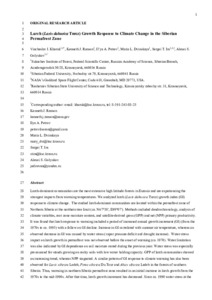Показать сокращенную информацию
Larch (Larix dahurica Turcz) growth response to climate change in the Siberian permafrost zone
| Автор | Kharuk, V. I. | |
| Автор | Ranson, K. J. | |
| Автор | Petrov, I. A. | |
| Автор | Dvinskaya, M. L. | |
| Автор | Im, S. T. | |
| Автор | Golyukov, A. S. | |
| Дата внесения | 2019-07-01T07:26:40Z | |
| Дата, когда ресурс стал доступен | 2019-07-01T07:26:40Z | |
| Дата публикации | 2018-08 | |
| Библиографическое описание | Kharuk, V. I. Larch (Larix dahurica Turcz) growth response to climate change in the Siberian permafrost zone [Текст] / V. I. Kharuk, K. J. Ranson, I. A. Petrov, M. L. Dvinskaya, S. T. Im, A. S. Golyukov // Regional Environmental Change. — 2018. | |
| ISSN | 14363798 | |
| URI (для ссылок/цитирований) | https://link.springer.com/article/10.1007%2Fs10113-018-1401-z | |
| URI (для ссылок/цитирований) | https://elib.sfu-kras.ru/handle/2311/110807 | |
| Аннотация | Larch-dominant communities are the most extensive high-latitude forests in Eurasia and are experiencing the strongest impacts from warming temperatures. We analyzed larch (Larix dahurica Turcz) growth index (GI) response to climate change. The studied larch-dominant communities are located within the permafrost zone of Northern Siberia at the northern tree limit (ca. N 67° 38′, E 99° 07′). Methods included dendrochronology, analysis of climate variables, root zone moisture content, and satellitederived gross (GPP) and net (NPP) primary productivity. It was found that larch response to warming included a period of increased annual growth increment (GI) (from the 1970s to ca. 1995) with a follow on GI decline. Increase in GI correlated with summer air temperature, whereas an observed decrease in GI was caused by water stress (vapor pressure deficit and drought increase). Water stress impact on larch growth in permafrost was not observed before the onset of warming (ca. 1970). Water limitation was also indicated by GI dependence on soil moisture stored during the previous year. Water stress was especially pronounced for stands growing on rocky soils with low water-holding capacity. GPP of larch communities showed an increasing trend, whereas NPP stagnated. A similar pattern of GI response to climate warming has also been observed for Larix sibirica Ledeb, Pinus sibirica Du Tour, and Abies sibirica Ledeb in the forests of southern Siberia. Thus, warming in northern Siberia permafrost zone resulted in an initial increase in larch growth from the 1970s to the mid-1990s. After that time, larch growth increment has decreased. Since ca. 1990, water stress at the beginning of the vegetative period became, along with air temperature, a main factor affecting larch growth within the permafrost zone. | |
| Тема | Larix dahurica | |
| Тема | Tree radial growth | |
| Тема | Larch forests | |
| Тема | Northern treeline | |
| Тема | Tree response to warming | |
| Тема | Larch and permafrost | |
| Тема | Growth index | |
| Тема | Climate impact on trees | |
| Название | Larch (Larix dahurica Turcz) growth response to climate change in the Siberian permafrost zone | |
| Тип | Journal Article | |
| Тип | Journal Article Preprint | |
| ГРНТИ | 34.35.25 | |
| Дата обновления | 2019-07-01T07:26:40Z | |
| DOI | 10.1007/s10113-018-1401-z | |
| Институт | Институт космических и информационных технологий | |
| Институт | Институт экологии и географии | |
| Подразделение | Базовая кафедра геоинформационных систем | |
| Подразделение | Кафедра географии | |
| Журнал | Regional Environmental Change | |
| Квартиль журнала в Scopus | Q2 | |
| Квартиль журнала в Web of Science | Q2 |

